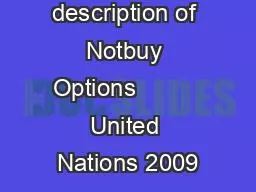

Detailed description of Notbuy Options United Nations 2009 Each of the steps identified below should be considered in order to determine whether to lease or buy Step Action 1 Add up all le ID: 895730
Download Pdf The PPT/PDF document "Detailed description of Notbuy Options ..." is the property of its rightful owner. Permission is granted to download and print the materials on this web site for personal, non-commercial use only, and to display it on your personal computer provided you do not modify the materials and that you retain all copyright notices contained in the materials. By downloading content from our website, you accept the terms of this agreement.
1 Detailed description of Not-buy Options
Detailed description of Not-buy Options © United Nations 2009 UUnniitteedd NNaattiioonnss PPrrooccuurreemmeenntt DDiivviissiioonn Not-Buy Options ake versus buy A make or buy analysis will result in the decision to provide the good or service by using internal Organisational resources or to contract out for similar support to meet a given need. For example, such decisions may arise as an internal consideration when a large programme considers setting up its own maintenance and repair shop versus contracting for the service outside; such decisions may also be appropriate where a government entity could provide the services using its own resources versus procurement on the open market; development of own software versus buying off the shelf. hen comparing costs between the UN Organisation and the market, the following principles should be followed: All cost comparisons should be based on an apples with apples approach. · The costs for maintaining the same service levels and quality should be considered. · Time required to produce and deliver the same product or service internally or externally should be considered. · Likely availability of internal expert resources to produce, deliver and maintain (as appropriate). · Impact on the programme/project if internal resources cannot deliver on time or with equivalent quality. · All costs should be included in the calculation, including e.g. administrative cost to the Organisation for both options. ease versus buy The Procurement Officer should compare the cost of leasing with the cost of buying an identical item. If the terms of the lease include other services, such as operation and maintenance, then the cost of obtaining these services separately should be added to the purchase price for the purpose of this analysis. The residual value of the item at the end of the p
2 eriod should also be considered. Deta
eriod should also be considered. Detailed description of Not-buy Options © United Nations 2009 Each of the steps identified below should be considered in order to determine whether to lease or buy. Step Action 1 Add up all lease payments for the expected useful life of the equipment. 2 Add to the proposed purchase price of the equipment any of the following costs that would apply: · Installation costs (one-time). · Maintenance costs anticipated over the expected useful life of the equipment (cumulative). If the leased equipment includes operator costs, then the Procurement Officer should add to the Buy option the actual costs of operation as could be paid by the end-user. · Any warranty costs not included in the purchase price (one-time). · Estimated delivery charges not included in the purchase price (one-time). 3 Subtract the resale value, if any. 4 Compare the total lease cost (option 1) to the total proposed purchase cost (option 2). See the example below. 5 Select the lower total cost of the two options as the most advantageous acquisition method. xample In the example provided in the table below, option 1: leasing, would provide better value. The procurement process would therefore change from buying the particular item to leasing. Option 1: Lease Option 2: Buy Useful lifetime 5 years Purchase price $10,750 Monthly lease $170 Maintenance cost (400/year) $2,000 Warranty cost 0 Delivery charge $150 Resale value ($1,500) Total cost to lease $10,200 Total cost to buy $11,400 ote: If the procurement value is substantial, then Net Present Value (NPV) calculations are needed to discount future costs in years 2, 3, 4, etc. to their present value, using the prevailing interest rates. This is necessary to compare the present value of the investment in both options and select the option that provides the lower NPV.